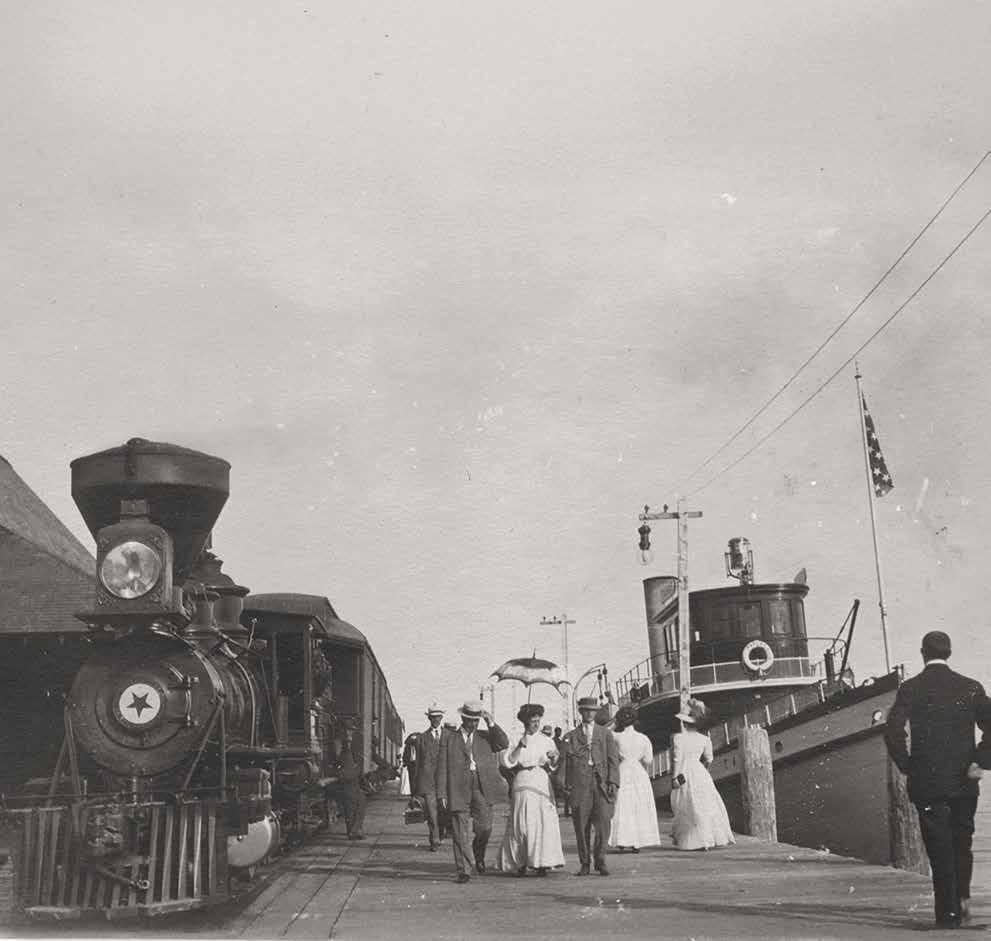

A Century of Memories
TAHOE YACHT CLUB
Lake Tahoe Railway & Transportation Co. SS Tahoe and Locomotive #3 on the Tahoe Tavern Pier circa 1908-1924. 1925 - 2025
Tahoe Yacht Club, Inc.
Tahoe City, CA 96145
www.tahoeyc.com
Tahoe Yacht Club: A Century of Memories, 1925-2025
© 2025 Tahoe Yacht Club, Inc.
All rights reserved. No part of this book may be reproduced or transmitted in any form, or by any means, electronic or mechanical, including photocopying, recording, or by any information storage and retrieval system, without written permission from the publisher.
First Edition 2025
Book and cover design by: Leisa and Robby Mayer Newcastle, CA
Published by: Pediment Publishing, a division of The Pediment Group, Inc. Vancouver, WA www.pediment.com
Printed in Canada.
ISBN: 978-1-63846-087-9
CENTURY OF MEMORIES
Tahoe Yacht Club
1925 - 2025
Tahoe Yacht Club
Tahoe City, CA 96145
Latitude: 39° 10' 18.81” North
Longitude: 120° 8' 15.97” West

TAHOE YACHT CLUB
Table of Contents

Commodores 1925 to 2025
1925-27: Edwin Letts Oliver
1928: George A. Newhall, Jr.
1929: Charles H. Kendrick
1930: Charles E. Townsend
1931-32: John B. Metcalf
1933-34: J. Carroll Skinner
1935: R. Stanley Dollar, Sr.
1936: Edwin Letts Oliver
1937: Brooks Walker
1938: Henry J. Kaiser
1939-40: Randolph C. Walker
1941: Gustav Knecht
1942-45: No activity during WWII
1946: Frank Fuller, Jr.
1947-48: Brooks Walker
1949-50: R. Stanley Dollar, Jr.
1951-52: Rudolph Zimmerman
1953-54: George Merriam Lewis
1955-56: R. Randolph Walker

1957-58: J. Philip Murphy
1959-60: J. Allen Bray
1961-62: Stanley W. Good, Jr.
1963-64: Michael A. Brown
1965-66: Hugh F. Mullin, Jr.
1967-68: L. Howard Good
1969: William Nagle, Jr.
1970-71: Lewis A. Marsten, Jr.
1972-73: Marshall Kraus
1974-75: Raymond Hellmann
1976-77: Ralph Peer, II
1978-79: Les Bartlett
1980: Ron Rupp
1981: William S. Briner
1982: Steven A. Lapkin
1983: Charles M. Crawford
1984: Glory A. Beall
1985: John Utter
1986-87: Steven A. Lapkin
1988: Clyde R. “Buzz” Gibb
1989: Dr. Frank Roberts
1990: Bryce Griffith
1991: Richard W. Loverde
1992-93: Howard M. Turner
1994-95: Michael Rosenauer
1996-97: Kenneth A. Selvidge, Sr.
1998: Richard M. Stout
1999: Craig Miller
2000: G. Douglas Ball
2001: Paul Walker
2002: Brad Hill
2003: Jim Gregory
2004: Donna Block
2005: Paul Cunha
2006: Jack McKenna
2007: Philip B. Ballantyne
2008: Stacy Conner
2009: Jenny Ludwig
2010: Andrew R. Wagner
2011: Hank Upton
2012: Bruce Block
2013: Dick Morton
2014: Tom O’Rourke
2015: Fred Greifenstein
2016: Bruce Ells
2017: Rick Raduziner
2018: Ray Landgraf
2019: Margaret Holiday
2020: Ross Arno
2021: Bill Krivan
2022: John Sakrison
2023: Sol Gold
2024: Lynn Mullen
2025: Ray Landgraf

Dedication
This book is dedicated to those who came before us, and for those who will follow—the members, families, and friends of the Tahoe Yacht Club—whose forward vision and passion for boating and love of Lake Tahoe allowed us to enjoy a “Century of Summers.” This year we celebrate that century, a time that passed so quickly, yet is so full and rich with 100 years of history. We sincerely thank those who guided our Club, imagined the events, the races, the fun and created camaraderie and community—all while enjoying boating, sporting events, hiking, golf, social activities, and parties—all the things that kept the fun alive!
For many decades, we were a Club without a home—places such as Sugar Pine, Homewood Pier, Sunnyside, and more served as “Our Home”. Essentially we were vagabonds, enjoying all that we had built, packed into the summer season! That is who we were until 1995, when we moved into our current home—the Clubhouse in Tahoe City. That milestone event allowed us to become a year-round entity filling those twelve months with unique events and activities that all members would enjoy.
This commemorative book serves a distinctive purpose—to showcase the history of how and why our Club has moved, grown, and changed over the eras of this century, highlighting the events and people that made the Club what it is today. As each new day arrives, we continue to create our history, each of us contributing our individual stories to the people and place that bring us pleasure, community and most of all, fun!
1925 Commodore
Edwin Letts Oliver, an innovator, mechanical engineer and inveterate Tahoe boater became the first Commodore of the newly established Tahoe Power Boat Club*. Oliver’s invention of the cyanide filter used in mining made him unique among his immediate successors. Many of them had family fortunes, the funds of which had been magnified through their involvement in white-collar enterprises, namely real estate, insurance and the law. That same mechanical mind made him instrumental in the organization of the early boating competitions. (* Name changed to the Tahoe Yacht Club in 1938.)
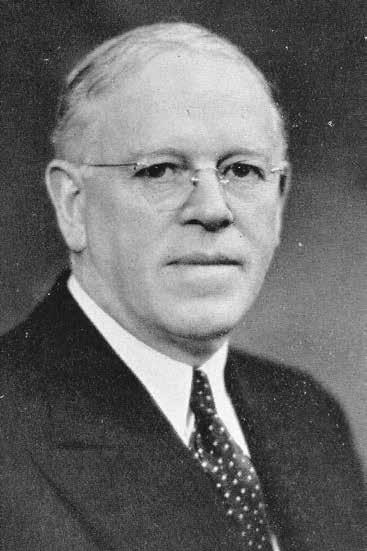

Edwin Letts Oliver, Commodore 1925-27, 1936.
100 Summers of Change
Perhaps no other 100-year period of time has seen the rapid rate of change that we have witnessed. We weren’t yet born in 1925, but many of our parents, and certainly our grandparents were. They saw and lived through so many changes: two world wars, regional conflicts, the advent of combustion engines, automotive and air travel, communication and the nuclear age.
Our generation has seen an even greater rate of change. As we landed men on the moon and brought them home, the real technological revolution began. Who would have thought that the phone we use today holds more computing power than the astronauts had when traveling to the moon.
The constant in our lives has been the love of Lake Tahoe and the opportunities it presents to relax and recreate. Change has been a constant here as well. Look at our early boats—Gar Wood, Hacker, Chris-Craft and Century—crafted of oak, cedar, and mahogany. The engines were carbureted. Today, fiberglass, resins, and composites are the materials of choice. The sails are Mylar and Kevlar. The engines are electronically fuel-injected. Witness the Roar-Off at Obexer's following the Concours. The great cloud of blue smoke as the engines fire up. Some changes are better!
As you flip through this book, you will be introduced to the people who were instrumental in our Club’s growth and longevity.
The Club was a summertime affair for many years, until we moved to our location in the Tahoe City Marina. It has become a year-round venue with permanent staffing to handle the day-to-day operations and communications with members. In 2018, we had about 260 memberships. Today, we have a capped membership at 450 and a waiting list.
The Pandemic changed the way we could meet and socialize. At the Club, it spawned new activity groups like the Hoofers, the Spokes, and the Blue Crew in addition to the already popular Eagles, Bocce Rollers, and Penguins.
True to its heritage of waterborne activities, there is powerboating, sailing, kayaking, and paddleboarding. The Club has evolved over its 100 years and has become a social place with much to offer its members.
Pat and I wish to express our appreciation to the members for allowing us the roles we have played at the Club. We have made lasting friendships. We have tried to act with a steady hand, welcoming the changes around us, and making the Club what it is—just a fun place to be.
On to the next 100 years. Changes are sure to happen. If only we knew what they would bring!
Ray Landgraf Commodore 2018 and 2025

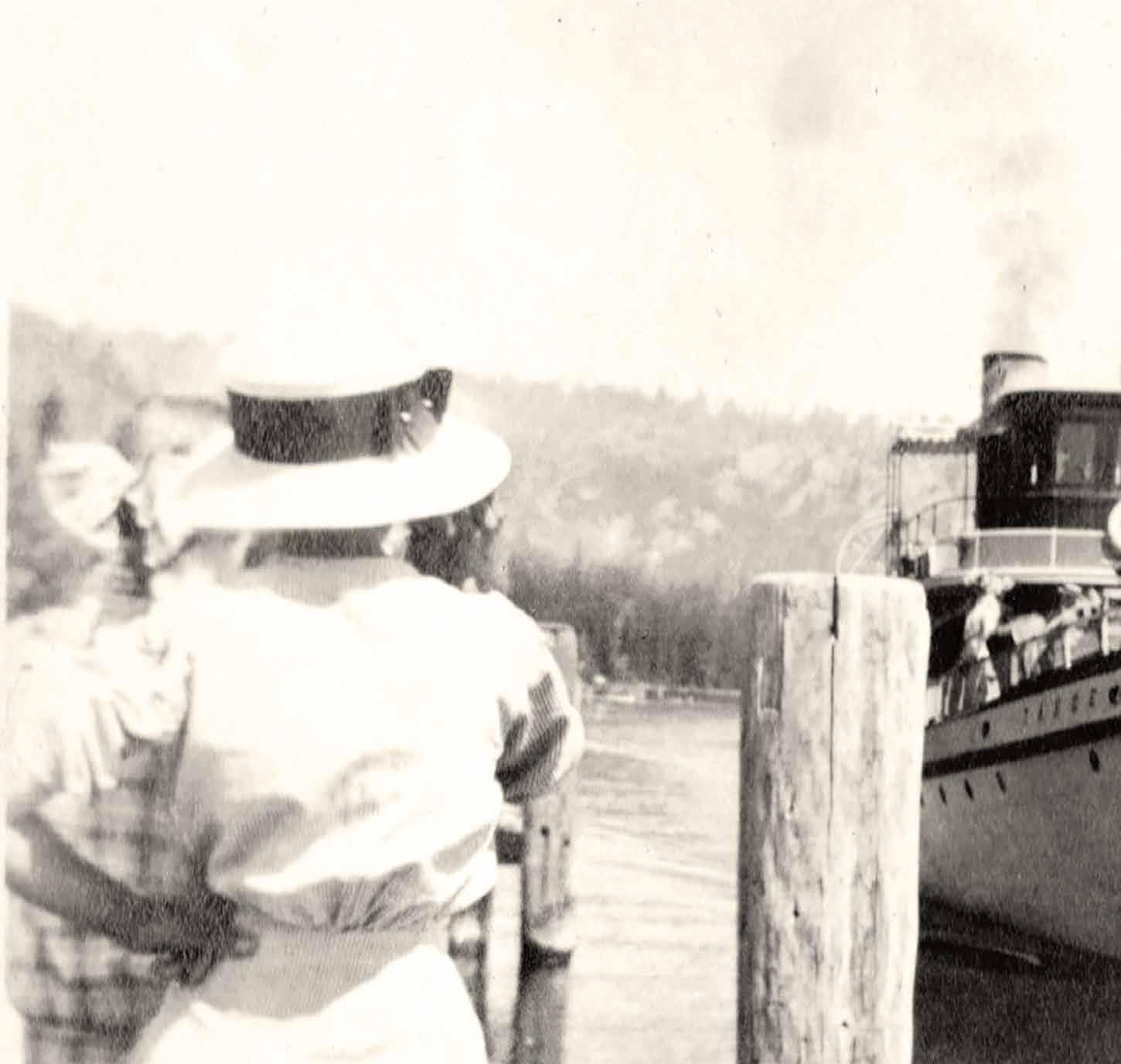
Preface
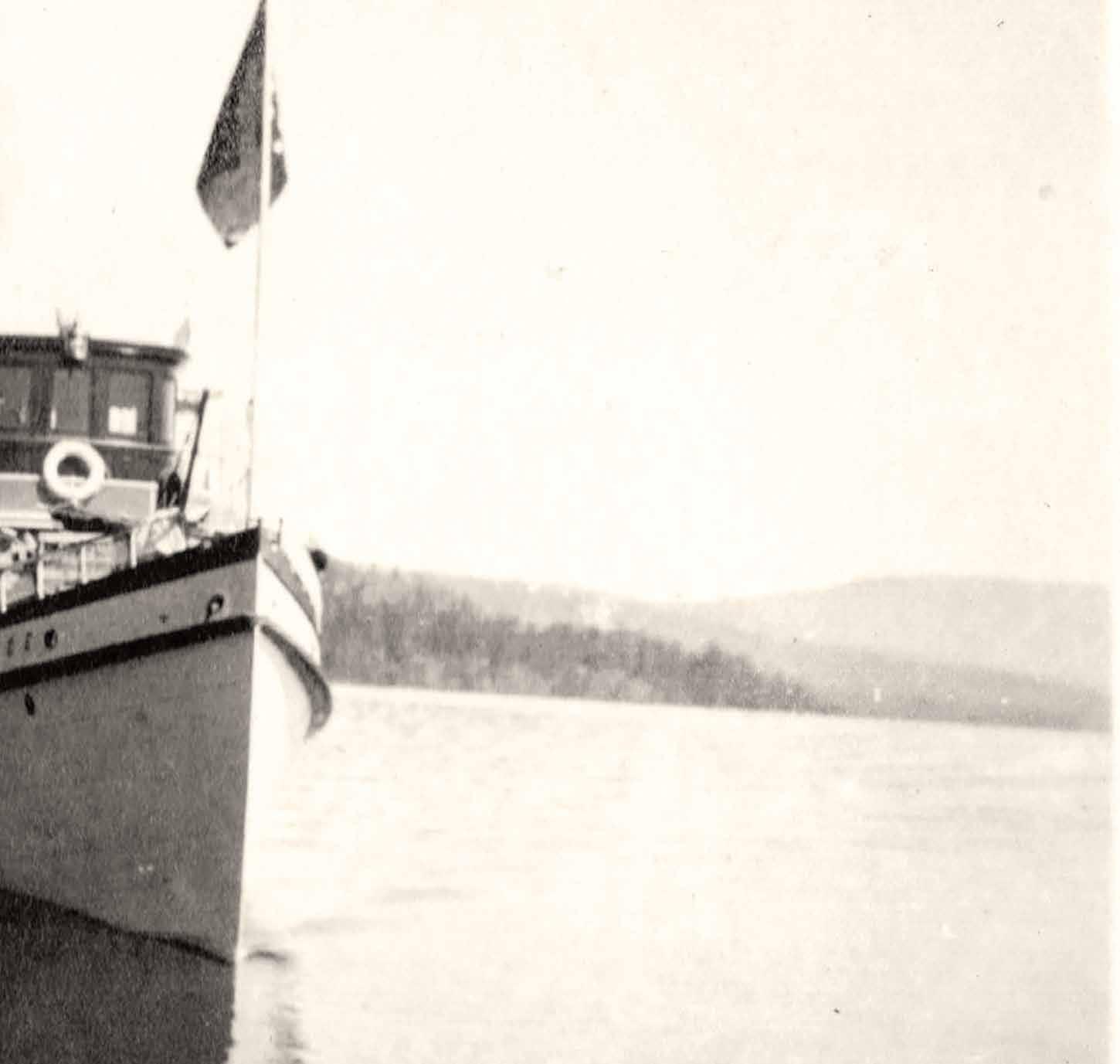
By 1920, Lake Tahoe’s unique physical attributes and ease of access by railroad made it one of the most celebrated watering holes of the West. For the West Coast capitalists who had made Tahoe their summer home, the acquisition of a motorboat to serve their recreational whims was imperative. At first, the boats were of the sedan and cruiser type formerly used on the San Francisco Bay. They typically ranged from 30 to 70 feet in length, and were steam powered and featured a cabin in which a number of passengers could be sheltered from the elements. Most required a small crew to handle and were best suited to leisurely group excursions. Next came smaller launches and as time progressed, other boats would be powered by gasoline, naptha or diesel.
However, during the same period, improvements to the newly developed internal combustion engine were encouraging the design of smaller, safer and more nimble craft, suggesting personal use and comparatively high-speed travel. Tahoe was the ideal West Coast playground for these sporty new boats, which were known as runabouts. Soon these boats were being commissioned by numerous Tahoe boaters eager for a thrill. Another smaller contingent of the Lake’s boating elite favored the toothpick-beamed open launches being built in the Stockton, California yard by brothers Thod (Theodore) and Roy (Robert) Stephens.
Tahoe's leading seasonal citizens were the captains of West Coast industry and commerce for a reason, and the same type A behavior that characterized their work guided their play. They would race whenever they met with the urge to organize impromptu competitive encounters. Normalizing and sanctifying their results was one of the two needs satisfied by the birth of the Tahoe Power Boat Club.
The second need felt by this favored circle of summer boaters was for an organization around which they could unite for social reasons. In any case, the early Tahoe mariners were careful not to call themselves a Yacht Club. They were merely sportsmen and a very few doughty sportswomen, most of whom liked to race and otherwise mess about in boats. Perversely, on July 9, 1938, a unanimous vote of the Tahoe Power Boat Club officers changed the club's name to the Tahoe Yacht Club with no reason given!
During the dozen summer seasons preceding Pearl Harbor, the Club's annual Regattas, usually two per season, boasted as many as seven racing classes. Races ranged from Outboards to Unlimiteds—conducted on the racecourses established at Tahoe Tavern and McKinney's Bay, later known as Chambers' Lodge. These contests continued through the 1941 season before being suspended “for the duration”.
Pioneering the Waters: Our Founders & Charter Members
Insight into the character of any group can be gained through knowledge of its founders, and in the case of the Tahoe Power Boat Club, six of its first seven Commodores—its ostensible founders—fit a profile that varies little in its particulars from one man to the next. All six men enjoyed a lineage blessed by inherited wealth, much of it dating to the Gold Rush, and for most members of this exclusive group, Tahoe had been a family watering hole since the early years of the 20th Century, if not before. All were graduates of California universities, some favoring Berkeley and the rest Stanford, and most were affiliated with a Greek fraternity, as well as such exclusive San Francisco enclaves as the Pacific-Union and University Clubs.

Below: Seven Tahoe Yacht Club Commodores are among the club's general membership in this photo, taken July 4, 1934, at the Tahoe Tavern lake entrance. Identified to date (left to right) Spencer Grant, Sr., J. Carroll Skinner (1933-34), Edwards H. Metcalf, and assistant club secretary Mrs. E.L. Adams holding the burgee with John Metcalf (1931-32). To Metcalf's left are R. Stanley Dollar, Sr. (1935) with hat in hand, Edwin Letts Oliver (1925-27, 1936) wearing knickers, Brooks Walker (1937), Gustav Knecht (1941), Edwin Letts Oliver, Jr., and R. Stanley Dollar, Jr. (1949-50) behind, second from right. The photo which now hangs in the entry way to the club was donated by Staff Commodore Glory Beall.

In short, the first six men to hold the office of Tahoe Power Boat Club (TPBC) Commodore were the nautically-inclined movers and shakers of West Coast capitalism, all but one maintained a presence within a few blocks of each other in the heart of San Francisco’s commercial district. Oliver and Newhall kept offices in the Newhall Building at 260 California Street, while Kendrick kept his office at 1284 Market Street, where it intersects with Larkin. Charles Townsend was a principal in the firm of Dewey, Strong and Townsend, with offices at 612 Market, and John Brockway Metcalf, who eventually moved his business address to Hearst Avenue in Berkeley, also began his career in the heart of the city’s financial district.
While the names of these social and financial pillars were not all household words, their influence, jointly and severally, was vast and thus their comings and goings were of interest to the public at large.
In the early years of the 20th Century, most of these founding Commodores maintained residences in the San Francisco neighborhoods of Pacific Heights and the Marina District, but the establishment of the East Bay community of Piedmont in 1922 encouraged four of the six to build sprawling new abodes there, all within a few blocks of each other.
EDWIN LETTS OLIVER
Leading the way in both this move to Piedmont, and in most every other activity in which he involved himself was Edwin Letts Oliver, the Tahoe Power Boat Club’s premier Commodore, whose invention of a continuous filter for use in mining contributed greatly to the making of his personal fortune. Oliver’s Grass Valley mining activities (the Idaho-Maryland Project) proved fabulously lucrative as well, and its resources are believed by some to be hardly exhausted, though an entity calling itself Rise Gold Corp, presently working to reopen the mine, faces strict opposition on environmental grounds.
As a son of William Letts Oliver, internationally prominent mining man and noted photographer, Edwin Letts Oliver grew up around boats, learning to sail on San Francisco Bay aboard his father’s
yacht Wave. They shared a middle name and love of things marine, and Edwin delighted in the opportunity to enjoy a different sort of boating on Lake Tahoe, where gasoline-powered personal watercraft were becoming the new thing. His first Tahoe motorboat was Hey There II, a Stephens “potato boat” (hull #501), first noted in the racing program for the Fourth of July regatta of 1929, where she took third place in the 100 HP race.
Being the organized, competitive person that Oliver was, his penchant for the friendly rivalry of the race course seemed to point to his selection as the Club’s first Commodore. On July 4, 1925, the day the Group first came into existence on paper, it was Oliver above all others whose dedication to the idea of an entity that could keep official score in organized competitions led to the development of a regular schedule of annual regattas.
Prior to WWII, the TPBC did not involve itself in social activities, since Tahoe’s Smart Set was basically San Francisco Society relocated to the Sierras, where a constant stream of private lakeside cocktail parties, brunches and BBQs quenched the need for Club-hosted social events. The general sentiment prevalent among members seems to have been that it was the purpose of the TPBC to conduct the races and help promote safety on the water, leaving the staging of social events to the hosts and hostesses among the group who chose to entertain.
GEORGE ALMER NEWHALL
The lack of Club archives for the first three years of its existence prevents much insight into its activities during this formative period. However, the extraordinary affluence of George Almer Newhall, the Club’s second Commodore, established a precedent that his successors, rich men though they were, would go far to duplicate. Newhall’s wealth was evidenced by such conspicuous circumstances as his ownership of two cruisers, the better to navigate between his two estates; one on Rubicon Bay and the other at Skunk Harbor. A pair of shingled multi-story boathouses, each with its own marine railway, flanked the shoreline of his Rubicon estate, providing shelter and launch facilities for Newhall’s extraordinary fleet.
Newhall’s Tahoe experience began in the era of cruisers, and during his lifetime he owned two such vessels, both acquired second-hand and both the work of John Twigg & Sons, the highly reputed San Francisco boatyard where most of Tahoe’s large boats were then produced.
The first of Newhall’s Twiggs was the 72-foot Consuelo, purchased from the Tahoe estate of his Burlingame neighbor, Lloyd Tevis. However, a mysterious blaze at Newhall’s Rubicon estate in June 1919 destroyed this boat and her tailor-made lakeside domicile, and he subsequently replaced her with Rubicon, a 70-foot Twigg originally built for C. Frederick Kohl.
Newhall’s enthusiasm for the new boat group included an offer of property - promptly rejected - for the use of its members. His cruiser Rubicon was frequently in attendance at all Club functions, and during the boom years of the 1920s, she could often be seen plying the Lake with a full complement of passengers whose names were the stuff of San Francisco’s Society pages.
However, Newhall’s boating tastes weren’t limited to the staid world of the Rubicon’s afterdeck. Advances in hull design and improvements in internal combustion engine technology were the inspiration for Newhall and several Tahoe contemporaries to purchase state-of-the-art “speedboats” in which to settle the question of who was fastest in annual grudge races. Newhall’s East Shore neighbor, Walter Hobart, Jr., liked to tear about in his Liberty-powered Orange Blossom, which Newhall later purchased and stored at Sand Harbor. International auto personality Norman DeVaux was another serious Newhall opponent who briefly owned a residence at Round Hill Pines on Zephyr Point, dominating the grudge match briefly in his Hacker-designed Apache. Newhall later bought Apache as well, renaming her Miss San Francisco before selling her to the Club’s fifth Commodore, Brockway Metcalf, who called her Tecolote II
Following Newhall’s death in 1929, his son and namesake maintained a membership in the Club and in 1938 was appointed by Commodore Henry J. Kaiser, Sr. to the Regatta Committee. Today there are no longer any Newhalls on the TYC roster.
CHARLES KENDRICK
Commodore Charles Kendrick was another Tahoe mariner accustomed to the silver spoon and a lifetime of idyllic summers at Tahoe. As a 19-yearold, he and friends Marco Hellman and Walter Scott Hobart, Jr. witnessed the 1906 San Francisco Earthquake and Fire from such a close vantage point that they had to use their coats to shield their faces from the heat. They would enjoy their places at the center of San Francisco—and Tahoe— Society all their lives.
Though Kendrick’s place in the family business promised a life of comfort, his 1909 appointment to the position of Manager of the Ocean Shore Railroad at the tender age of 23 and his own pluck led him to tremendous success in the world of suburban real estate. As chief promoter of a development called Granada Beach as well as the town of Chowchilla, he made business connections that would assure his standing in California—and thus Tahoe—Society.
Just as Kendrick was beginning to reap the spoils of his entrepreneurial boldness, the First World War intervened. He served with distinction in the Army, gaining fame for enabling the famous donut-making McIntyre Sisters to pass through the front lines undetected by the Germans. Kendrick was also cited for “display of exceptional devotion to duty while under bombardment in the Meuse-Argonne offensive” and following Armistice he was promoted to Major, the rank he held when discharged in February 1919.
In 1941, Kendrick’s distinguished military career was acknowledged with the naming of a destroyer in his honor, and in 1961 construction was begun on Kendrick Hall, University of San Francisco’s new law school building named for him.
Charles Kendrick owned one of Tahoe’s first Gar Woods, but son Marron recalled that his father’s 1927 triple cockpit model, named Navajo, featuring unique black-painted topsides, was not acquired through Jake Obexer and was always stored by Chris Nielsen at Sunnyside. Navajo was a family treasure, and she continued to appear in the TPBC roster through the last prewar race in 1941, though there is no evidence that she ever actually competed in a regatta.
On his retirement as TPBC Commodore in 1930, Kendrick encouraged the Club’s continued devotion to safety and the marking of hazards for the good of the general public, and called for a budget with no more than half the group’s income devoted to trophies.
When Kendrick died in San Francisco in 1970 he was President of Schlage Lock and SOS (the company of soap-impregnated steel wool pads), as well as Past President of the Bohemian Club, Press Club and Pacific Union. However, he may have been proudest of his term as third Commodore of the Tahoe Power Boat Club.
CHARLES TOWNSEND
It was the facile pen of Charles Townsend, the Club’s fourth Commodore, which in 1931 defined its recreational purpose as “merely an adjunct of a happy vacation period.” The Berkeley-educated Townsend was noted in the 1908 Oakland Directory as a patent lawyer, and by 1910 was listed on Piedmont Avenue in Alameda. By 1913, he had moved to 156 Dracena, Piedmont, only a few blocks from the Edwin Letts Olivers' home.
Townsend’s claim to fame in the realm of jurisprudence was his 1914 penning of a legal opinion on the subject of Intellectual Property that received a favorable review in the literature.
Townsend was faithful to his first Tahoe displacement boat - a 26-foot Stephens Brothers launchlong after most of his contemporaries had defected to peppier planing hulls when technology or styling changes were introduced. In the mid-to-late 1920s, Townsend’s launch Kanigo was one of a dozen 100 HP models (powered by Scripps F-4s), forming a racing class in which the participants always managed to finish in a nearly dead heat.
The 1937 season was the last in which Charles Townsend raced Kanigo in the regattas, for in 1938 he was competing in his new 225 HP Chris-Craft, Kanigo Too. However, his daughter Barbara, one of a small group of female competitors, took over Dad’s “potato boat” Kanigo to compete in the 100 HP race for at least one more season.

JOHN BROCKWAY METCALF
John Brockway Metcalf was a Berkeley native and 1899 UC Berkeley graduate who matriculated one year ahead of E.L. Oliver, earning a Bachelor of Science degree in Mechanics. As evidence of his devotion to the developing science of the internal combustion engine, Metcalf was one of only 13 automobile owners in Berkeley in 1905, the same year he also managed to marry the lovely Elizabeth V. Huntington, niece of Collis P. Huntington of Central Pacific Railroad fame.
Metcalf epitomized the Gentleman Sportsman, passing his great enthusiasm for life, especially things nautical, along to his three sons, Edwards, John and Lawrence, all of whom, as young adults, became members of the Tahoe Power Boat Club.
Metcalf’s boating biography spanned two eras, and as his sons became old enough to assume responsibility for their care, he supplemented his original
enclosed cruiser Raisa (named for a famous opera singer of the day) with his purchase of the Hacker speedster Apache II (renamed Miss San Francisco) from the estate of George A. Newhall.
These boats were followed in 1935 by a Scripps-powered triple-cockpit Gar Wood that he named Tecolote (“Night Owl”), and which sons John and Lawrence delighted in racing in the TYC regattas. This boat was still in the family long after his sons were grown, bringing happiness to a third and fourth generation.
JOHN CARROLL SKINNER
Sixth man to hold the office of TPBC Commodore was John Carroll Skinner, admirer of mechanical pulchritude, handy with a wrench and possessing the enthusiasm of a born promoter. Skinner was first among the Founders to have his roots outside the San Francisco Bay Area, being a Stockton na-
tive and thus partial to the boats produced by the Stephens Brothers yard located there. By the time the TPBC came into being, Skinner was already a veteran of two decades of auto racing, which had taken him all over Central California in pursuit of new speed and elapsed time records.
In November 1907, driving a Mitchell, Skinner set a new elapsed time record for a trip between Stockton and Modesto. Eighteen months later, he declared bankruptcy, but his value to the infant auto trade was evident to many, and within the next few years he would become an agent for several auto manufacturers, Knox and Wilton among them, who would put their faith in his knowledge of the market and of the cars he represented (both statistically and mechanically) to move their products out of the showroom and onto the Open Road.
During the first two decades of the 1900s the challenge of being the first autoist to surmount Echo Summit each spring was one taken up by many a would-be hero, and “Daredevil” Cal Skinner and his brother Ralph were among them. The brothers failed in their attempt in 1911 and had to turn back, but the idea of an auto event had them in its grip, and two years later Skinner was chosen to head Stockton’s Fourth of July celebration, one of its chief features being an auto parade.
In 1919, Skinner hatched a campaign in his hometown of Stockton that he dubbed “See Tahoe First,” and though it met with opposition owing to lack of accommodations at the north end of the Lake, Skinner continued to advocate for his favorite Lake (a blessed escape from the Valley heat in the days before air conditioning) and from that time forward focused his promotional talents on things Tahoe, chief among them the TPBC.
The Founders of the Tahoe Power Boat Club probably had no expectation that the organization they established would live to see the 21st Century—much less its own Centennial—but the good times and organized competition that prompted its birth are still in vogue and so, in consequence, is the TPBC.
Passengers enjoying a trip on board the Lake Tahoe Railway & Transportation Co. SS Nevada circa 1909-1925 in Tahoe City.
Tahoe Tavern
At the turn of the 20th Century, Tahoe Tavern was still in the design stages. An elaborate resort envisioned by Tahoe businessman Duane L. Bliss was planned for a beautiful stretch of land overlooking the shore of Lake Tahoe near his steamship pier. The terminus of Bliss' Lake Tahoe Railway & Transportation Company, narrow-gauge railway (later converted to standard-gauge by the Southern Pacific Railroad) shared the pier and would allow Tavern guests to debark at the resort. Quite a remarkable end to their journey, Tahoe Tavern would be an elegant wooden structure rivaling the European hotels of the era. Construction began in 1901 and by 1925 the Tavern had grown into an establishment that included a casino, grand dining and ballrooms, a plunge pool, tennis courts, golf course, bowling alley, beauty, barber and gift shops to assure every comfort for their guests.
The Tahoe Power Boat Club’s membership found the Tavern a comfortable environment to accommodate their social and recreational requirements during the summer season at “the lake” and determined it to be their “club meeting place", printing its name on their Club letterhead. A racecourse for their regattas was to be available and the race program included in the Tavern’s list of entertainment. Race days would see the Tavern’s piers packed with spectators anticipating an exciting spectacle from both boats and drivers.
Management of the Tavern was quite generous with its support of the Club’s regattas, providing donations toward the cost of the trophies and other items awarded to race winners. A note in the Annual Meeting minutes of the TPBC states “Mr. Jack Matthews, Manager of the Tavern, offered $100.00 toward trophy cups for the races held July 4, 1927. This offer was accepted with thanks.”
This close relationship between the Club and Tahoe Tavern continued through 1941, with at least one regatta each summer staged on its exciting course. Notable members like the Ehrmans, Dollars, Fleishhackers, Walkers, Kaisers and many others raced their boats, enjoyed the hospitality and marveled at the movie stars and entertainers who graced the Tavern ballroom and stage.
It was a historic and sad occasion when the Tavern was demolished in late 1964 to make way for the first of the condominiums that would cover the magnificent gardens and sloping lawns that so contributed to the beauty of the gracious and irreplaceable “Queen of the West”. The Tahoe Power Boat Club which would become the Tahoe Yacht Club survived this tumultuous century of change and growth while its first “partner” in assuring that boating and boats maintain a constant presence and provide a level of joy and fun on Lake Tahoe was lost in the shuffle of time.

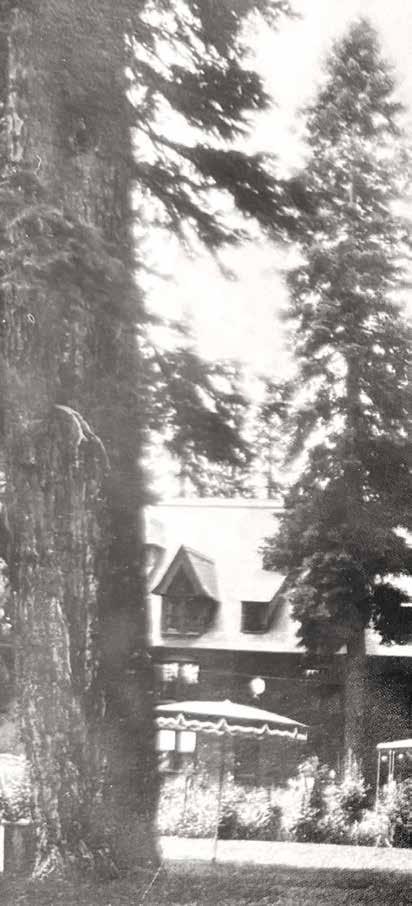
Southern Pacific train to/from Truckee on the Tavern pier.
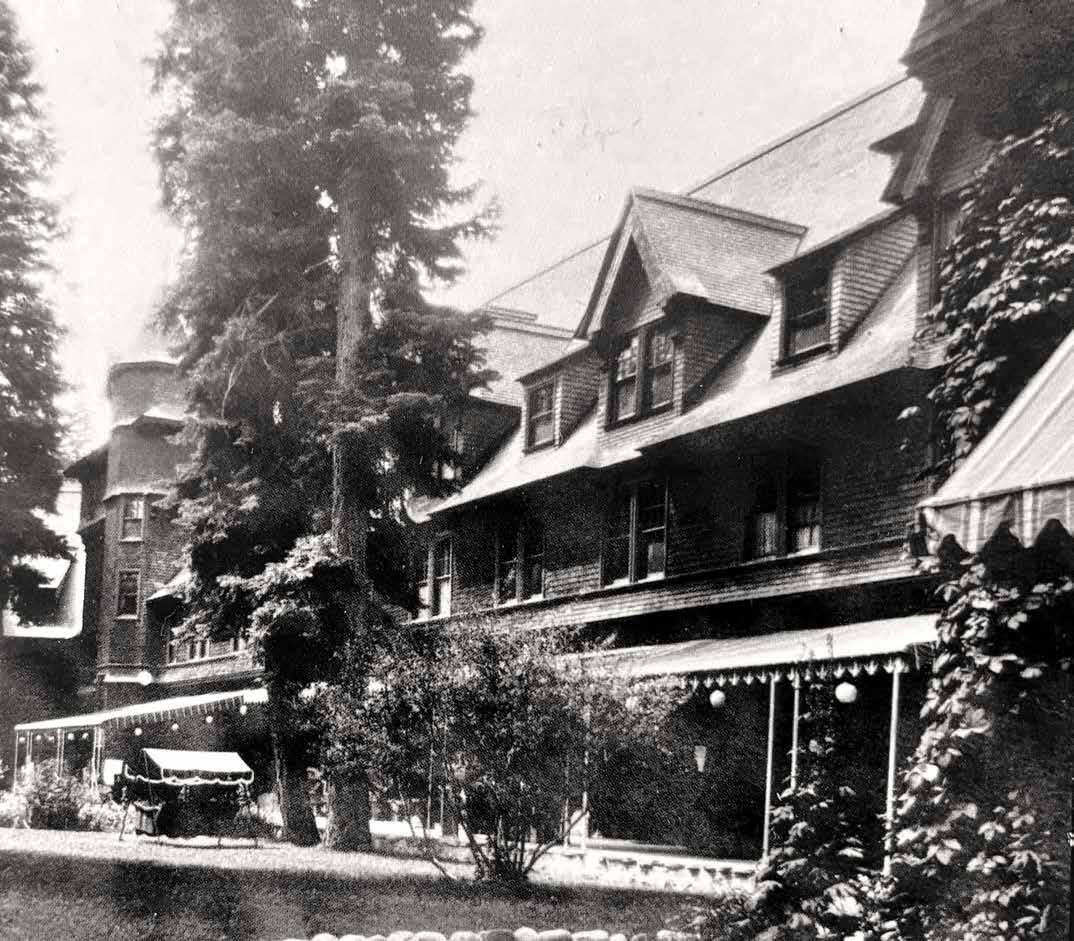
Tahoe Tavern.
Chambers’ Regattas & Water Ski Carnivals
It was not until 1937 that Chambers' Lodge became a regular site for the Tahoe Power Boat Club’s summer regattas. Prior to that time, races were held on the Tahoe Tavern course as well as the ones laid out in Hurricane and McKinney Bays. In 1934, Dave Chambers invited the Club to hold their next regatta at his lodge. He proposed using the time-honored McKinney course for the races in the waters offshore where spectators would have an inviting view. He sweetened the deal, inviting all Club members to enjoy an elaborate luncheon on the day of the races. Both regatta and lunch were a success, and Chambers' became a welcome location for a yearly regatta and, of course, the accompanying luncheon. A tradition was set for the next four decades.


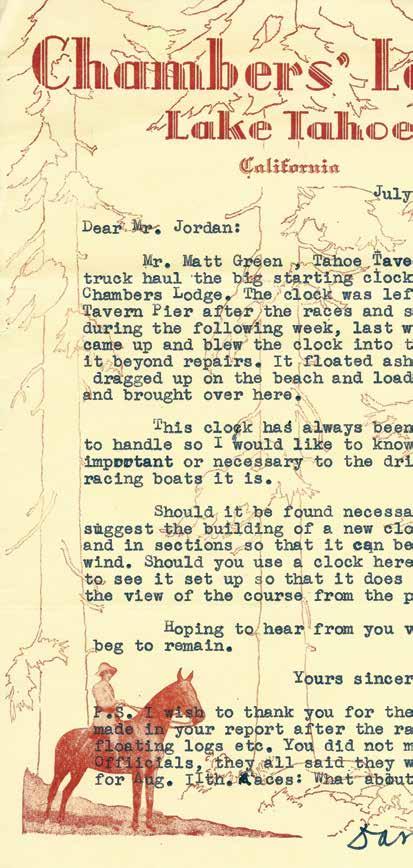
David Henry Chambers and Muggins.
Chambers' Lodge Bar, dock and cabins in the early 1960s.
During the war years, no races were held, but as post-war activities began again, Chambers staged his first regatta of the summer season in August 1946. This was the first season, too, when folks were restless, and many tourists and families seeking a nearby place to vacation found Lake Tahoe and its friendly resorts.
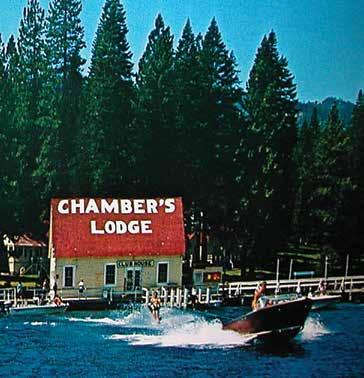
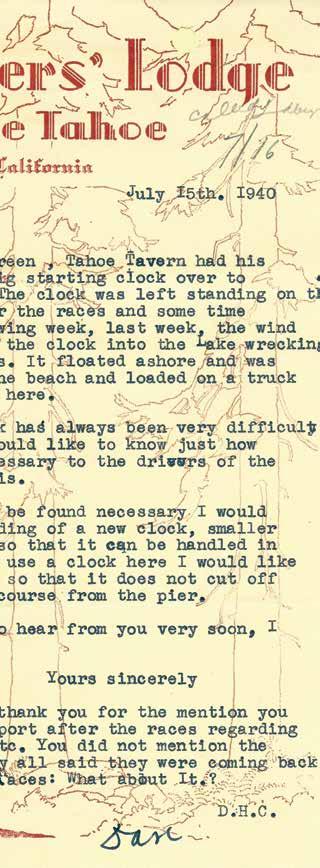
Chambers' Lodge continued to entertain with a yearly regatta, and in the early 1950s, the first Water Ski Carnival was held at Chambers'. Sponsored by the Tahoe Yacht Club, it was a great success from the beginning. An entire weekend of boat races, ski and Junior outboard races, and talented contestants showing their skills at skiing, aquatic magic, and fun. These Carnivals, which became an annual event, were well attended and provided entertainment for the families along the West Shore. Chambers' also hosted Sunday morning boat races for many of the local kids and young visitors alike.

Unfortunately, David Chambers, the mastermind behind this very successful establishment, died in 1952. Management of Chambers' Lodge was taken over by David’s brother, who continued the very successful summer events for another five years before selling. The new owners, though, retained the Lodge’s name. To this day, Chambers' Landing and Chambers' Punch are legendary along Tahoe’s West Shore—resounding in the memory of anyone who sat sipping punch, watching the sun set over the Lake and mountains.

Tahoe Tattler 24 July 1958
Water Ski Carnival
sponsoring the Sixth

the
course on Aug. 2 and 3.
will be held on Saturday, August 2, from 9 a.m. to 1 p.m. The trick and exhibition events are scheduled for Sunday from 9 a.m. to 1 p.m. Registration must be made before August 2 at 10:00 a.m. Entrance fees are $2.00 tor those 17 years and under; $2.00 for Club members over 18, and $3.00 for non-Club members over age of 18. Trophies will be on display at Chambers' Lodge and will be given out immediately after the standings are known following the last event. The Water Ski Carnival committee consists of A. R. Westphal, chairman; Mike Brown, Bob Dobbins, Susan Good, Ed Irvine, Pat Patterson,
The Tahoe Yacht Club is
Annual Water Ski Carnival program at
Chambers' Lodge
The slalom
Ralph Peer, Jr., and Gloria Westphal.
1958 TYC Water Ski Carnival, Calypso Dollies: Sue Good, Stannie Good, Gloria Westphal.
1958 TYC Water Ski Carnival: J. Philip Murphy, Sue Good, Gloria Westphal (1st place), Stannie Good, Randy Walker.
Henry J. Kaiser and His Winning Ways
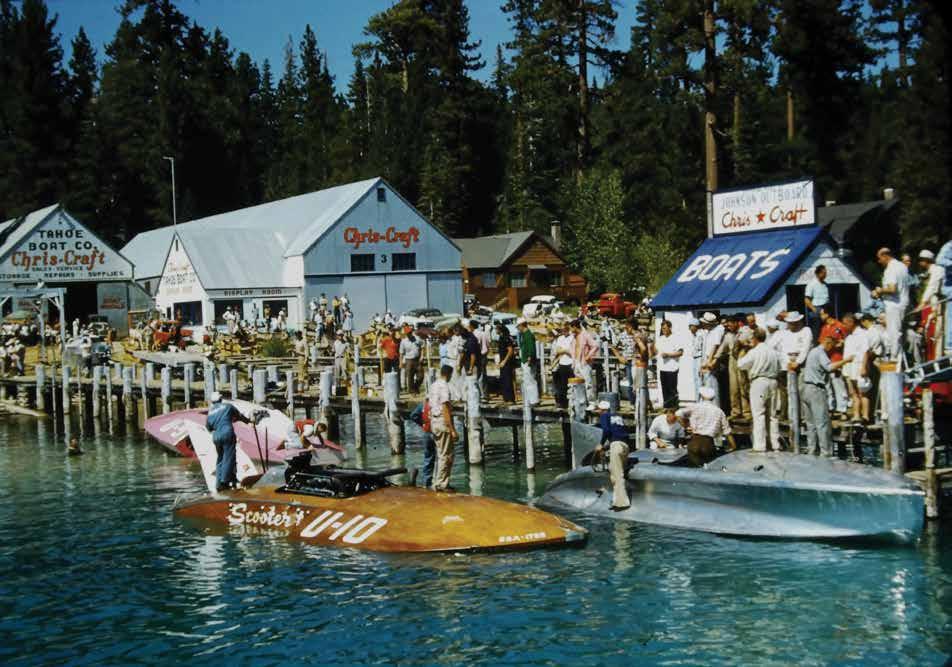
Arguably one of the most famous of the Tahoe Yacht Club’s Commodores, Henry J. Kaiser, is a member that many know little about.
1955 Lake Tahoe Mile High & Mapes Gold Cup in Tahoe City with three Kaiser boats, Hawaii Kai III, Scooter Too and Fleur du Lac (formerly Hornet II).
HENRY J. KAISER - 1938
From the time of his arrival on the Tahoe scene, Kaiser became preoccupied with boat racing, often against his most famous rival and fellow industrialist, R. Stanley Dollar, Sr. (Commodore 1935), and his son, R. Stanley Dollar, Jr. (Commodore 1949 –1950). These early activities led to Kaiser joining what was then called the Tahoe Power Boat Club where he was determined to make “a big splash”! In July 1938, he was elected Commodore, coinciding with the Club’s name change to the Tahoe Yacht Club.
During the next 20 years Kaiser would race boats including Bess, a 33’ Baby Gar (named for his wife), against Dollar’s 1924 Nevins race boat, Baby Skipalong, a two-time winner of the famous Gold Cup Races. Kaiser, liking to hedge his bets, often entered two boats in the same race. During the 1937 race season that strategy backfired when, unfortunately, his Bess, the 1935 Lake Championship winner, met an early demise, burning at the Tahoe Tavern dock just one hour after the first race!
In later years Hornet II, a 29.6’ step-hull Gar Wood, Lemme Go First, a late 1920’s raised deck Gar Wood and the “jet age” aluminum Hot Metal and Scooter were among his flotilla of Lake Championship and Lake Tahoe Mile High Mapes Gold Cup Unlimited Races entries. According to Kaiser’s official biographer, Albert Heiner, Kaiser’s boats “in his first half-dozen years of racing, won more than 30 trophies”. Hornet II (later under the name Fleur Du Lac) took eight Lake Championship trophies from 1936 to 1951.
Kaiser, who also had a love for the beauty of Lake Tahoe probably born of his early days at Lake Placid, was busy with other projects during these racing years.
In 1935, he purchased 16 acres of lakefront property on Tahoe’s West Shore at what is now known as Tahoe Pines. He proceeded to build his famous Fleur du Lac estate in an incredible 30 days!! Kaiser used his usual way of completing any construction project—build as fast as it could be done and faster than anybody else would even dare to try! His crews, working literally day and night, filled the swamp (probably today known as

protected wetlands) created by Blackwood Creek’s entry into the Lake. Neighbors noted a plume of silt in the Lake caused by the building but by the time their formal complaint was filed, construction was finished.
The Kaiser family enjoyed Fleur du Lac for many years, entertaining many prominent people of those days such as Governor Pat Brown and “Captain of Industry” Howard Hughes with whom Kaiser worked on the 'Spruce Goose' and other projects. Kaiser’s son, a resident of Orinda, continued to use the estate until it was sold in 1962 for $387,500. By then, though, Kaiser’s interests had moved on to land development in Hawaii.
Henry J. Kaiser was born in Sprout Brook, New York in 1882. His formal schooling ended at age 13 though he spent the rest of his life learning. By 1900, he was a photographic equipment salesman and while traveling to Lake Placid that summer, he met Bess. Obviously smitten, he asked for her hand but Bess’s father forbade the marriage until Kaiser had made a certain amount of money and built her a house. Like so many before him, Kaiser
moved West and in 1907, meeting both requirements, he and Bess were married. By 1913, they were settled down in Oakland from where Kaiser embarked on an extraordinary career. Beginning in construction, he quickly built an industrial empire that included public works projects, roads and material (concrete, asphalt, aluminum) as well as the WWII “Liberty” ship and established the Kaiser Permanente Health Care system. After a very busy 85 years, Kaiser passed away in Hawaii. One of his final projects was developing a residential area and a world class hotel on Oahu.
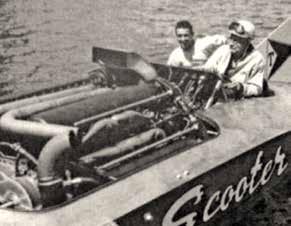
Staff Commodore Kaiser (far right) is all smiles in this trophy picture with (from left) Bobo Rockefeller, Jack Regas and Mrs. Henry J. Kaiser, II. Regas drove Kaiser’s hydroplane, Scooter Too (below), to a first-place finish in TYC’s August 1954 Regatta.
R. Stanley Dollar, an Unsurpassed Racing Legacy
R. Stanley Dollar Jr. left an indelible mark on Lake Tahoe’s boating history, surpassing all others in skill, sportsmanship, and enthusiasm. Born in 1915, he inherited not only a fortune but also the adventurous spirit that defined his family’s success in the Dollar Steamship Company, one of the world’s largest corporations.

Stan Dollar Jr. and Ollie Meek in Skip-A-Along of California.
His grandfather, Robert Dollar, built a financial empire from humble beginnings as a lumber camp worker in Canada. Through diligence and business acumen, he amassed vast timber holdings, eventually moving his enterprise westward to California in 1888. To transport his products internationally, he purchased the steamer Newsboy in the 1890s, launching what became a dominant steamship dynasty. His success culminated in a fleet of 32 vessels by the 1930s.
While the shipping empire flourished, a new arena for competition emerged—powerboat racing on Lake Tahoe. In 1927, R. Stanley Dollar Sr. purchased the Wychwood estate, including Observatory Point (later known as Dollar Point), and a fleet of boats ill-suited for racing. Recognizing his son’s passion for speed, he acquired a powerful outboard, Stanley Bullet, allowing young Dollar to compete in the newly formed Tahoe Power Boat Club’s regattas.
In 1929, the elder Dollar purchased Baby Skipalong, a championship race boat, catapulting his son to victory. Over the next twelve seasons, Dollar Jr. dominated Tahoe racing, developing a reputation for both competitive prowess and sportsmanship. By 1935, he had expanded his reach internationally, racing in Paris, where an accident nearly cost him his life.
The late 1930s saw fierce competition between Dollar and industrialist Henry J. Kaiser. The title of Lake Tahoe Champion seesawed between them, culminating in Dollar’s triumphant 1939 race in Miss Golden Gate. World War II paused the rivalry, but postwar innovations led Dollar and partner Ollie Meek to construct Skip-A-Long of California, an aluminum hydroplane that dominated the 1949 international season before sinking in Lake Tahoe’s Hurricane Bay.
Undeterred, Dollar acquired the remains of Miss Peps V, transforming her into Short Snorter. She won the 1952 Lake Tahoe Championship and the first Gold Cup race at Tahoe in 1953. By the mid1950s, Dollar transitioned from competition to family life, marking the end of an era in Tahoe powerboat racing. In 1975, at the Tahoe Yacht Club’s 50th anniversary, he made a final appear-
ance with Baby Skipalong, a poignant farewell to a legendary career.
R. Stanley Dollar Jr.’s legacy was not merely in victories but in his unwavering sportsmanship and passion for the sport. His guiding principle, “Never Come Home in Ballast,” embodied a life rich in adventure, achievement, and integrity.
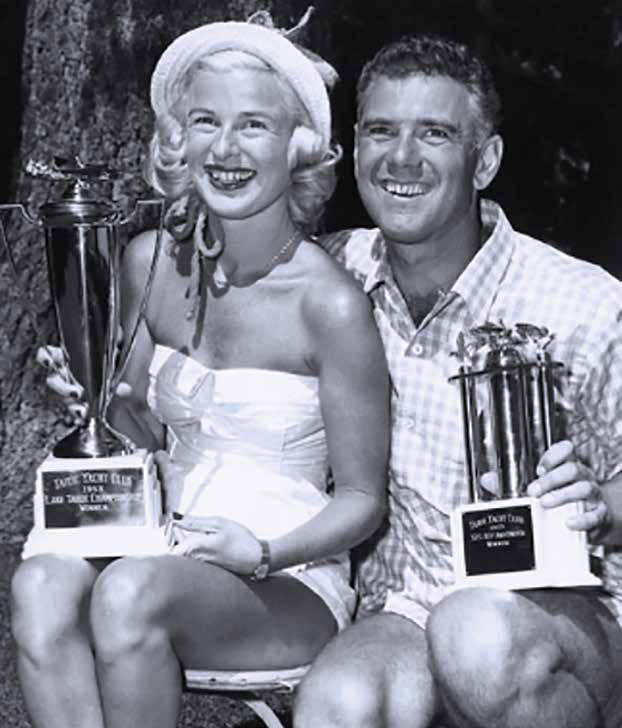
R. Stanley Dollar Jr. & wife, Nancy.
Edward “Bud” Scott – Saving the History of Lake Tahoe
Bud Scott is primarily known for his remarkable pictorial histories, The Saga of Lake Tahoe Volumes I and II. He is a fourth generation Californian, having grown up in the Bay Area and Lake Tahoe. His passion for writing began in college at the University of Washington and University of California, Berkeley. Bud’s early working career was fairly conventional. However, in the 1940s he moved to Lake Tahoe full-time. In those days at Tahoe, one needed to be involved in various enterprises, so for 26 years he operated a commercial boating business along Tahoe City's shoreline. During this period his interest was piqued by the history and legends of the Lake. He began to interview local old-timers, capturing their stories, memories, tall tales and photographs when he could get them. Tahoe proved to be a perfect environment for writing with an incredible history to chronicle in his books.
During the 1940s to the early 1960s, the best way to get on the Lake was a boat ride from Bud Scott and, happily, the Captain would expose them to the facts and legends of Tahoe. The successful 1960 Olympics, though, changed many things. Beautiful resorts on Tahoe were torn down, replaced with condominiums, making Bud’s boat business less viable. Interstate 80 opened and it was possible to trailer your own boat to the Lake.
Time was right for writing, and, after many years of research, The Saga Volume I was released in 1957. Bud put his efforts into the book’s distribution, often sitting at the fountain of Jay Shontz’s Drug Store in Tahoe City, autographing books. His favorite dedication was to “a young old-timer of Tahoe”. Saga Volume I was a success and encouraged by that, in 1973, Saga Volume II was produced.
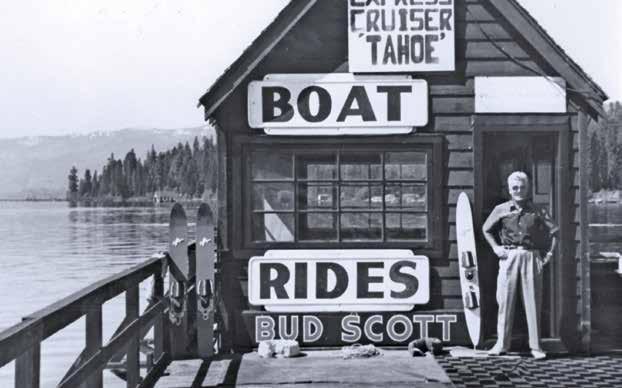
The winter of 1951-1952 challenged everyone with its huge amounts of snow. Wintering in Carmel or Hawaii became more preferable. In the 1960s Bud built a home on Oahu and started his research for The Saga of the Sandwich Islands. Tahoe always remained home for summers.

THE SAGA OF LAKE TAHOE VOLUME I & VOLUME II
The Sagas of Lake Tahoe, which E.B. Scott so meticulously wrote, remain the most definitive documentation of the history and development of the Tahoe basin. His passion for writing and love of Tahoe history is obvious. It’s well-researched, documented and entertaining pages continue to enthrall readers and be a necessary resource for knowledge seekers and researchers. The collection of his works, notes and photos are in the Bancroft Library at the University of California, Berkeley. As son Ed “Skip” Scott proudly states, “Bud is truly the man who saved the history of Lake Tahoe”.
Bud Scott at his boat shop on the old Tahoe Tavern pier where he operated cruises, charters and taxi rides in the 1950s.
Memories from son, Ed Scott
Ed “Skip” Scott
When first asked what he loved about spending so much time at Tahoe, Skip, after thinking for a bit, spoke with a little “catch” in his throat, “It was just magical, a special time, every day was a new adventure! The local folks were a tight-knit group and the summer people helped out whenever they could, bringing an added measure of support to the whole community. Everyone looked out for one another. You were safe to walk around anywhere; all the way into Tahoe City; sit at the fountain at Jay Shortz’s Drug Store and nobody would bother you. At Christmas time we would all go down under Big Tree to celebrate—Santa would come—there were presents for all of the kids and plenty of good food. It was a wonderful time!”
“We stayed through the year a couple of times and I went to school with the local kids and made lots of good friends. I made my First Communion at Corpus Christi. Tahoe Tavern was the best place, really the “center of my universe”. My Dad rented part of the Tavern’s pier to keep his boats so, in the morning I went down there to wash the boats and at noon I would go up to the coffee shop to eat. I knew all of the employees, even Sam the Barber and his wife knew me; so did the theater manager. When I went to the movies there were bats flying around by the ceiling. It was a great place and there was lots to do.”
“We lived near Cedar Point and on some of those warm summer days, I would take Pepper, my dog, and we would walk through the woods down to the State Road. I’d take a bunch of Sugar Pine Cones and my money can and we would sit by the side of the road waiting for the tourists to drive by. Maybe only one car would come by every half hour but they would stop, and I would sell them some cones”
“It was a small community, about 320 local people. When I was younger and came back each summer to work at Sierra Boat, those special people were still around. I lived with Pat Bagan (General Manager of Sierra Boat) during the summer months and we had fun. Even at 18, I had a charge account at Sunnyside!”
“Thinking back, it was a really great experience growing up in that time—a great era. Sometimes, just sometimes when I’m lucky, I get a little glimpse of it somewhere, just enough to remind me of how it was."
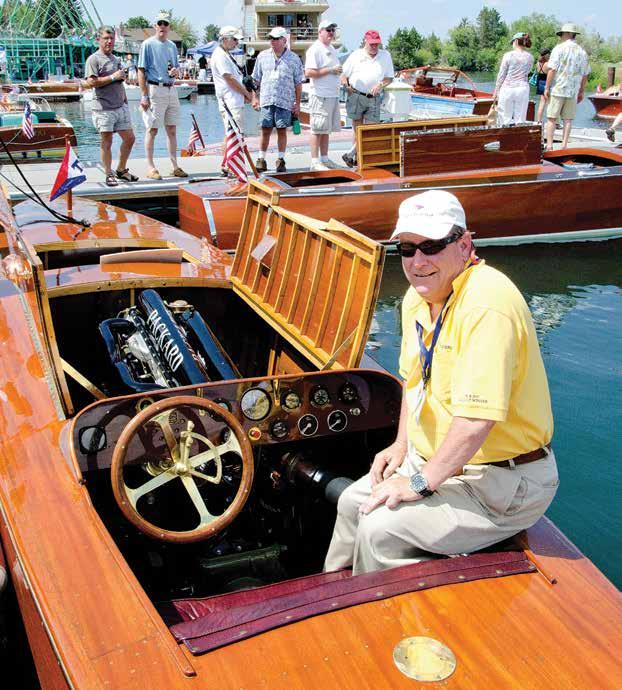
Ed Scott sitting on Baby Skipalong showing her rare original Packard 1M-621 Gold Cup race engine.
Memories from Ed "Skip" Scott
